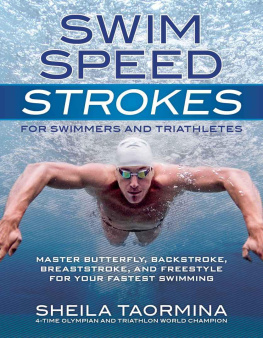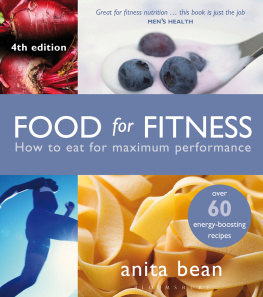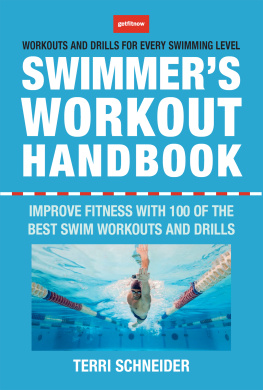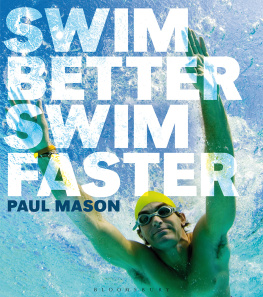Table of Contents
PREFACE
Hello, my name is Abby Knox. I am a registered dietitian and sports nutritionist, swim coach, athlete, mother of competitive swimmers, and wife. This combination (apart from the wife bit) has allowed me to see firsthand how nutrition affects my own athletic performance, the athletic performance of my children, also the performance of the swimmers I coach. Your body is like a high-performance car that needs the right fuel to perform at its best. By fuelling your body with the right nutrition, you will be able to train harder, recover quicker and give yourself an advantage over more talented swimmers with poor nutrition!
Nutrition is a complex subject. Add sports food advertisements, food fads, and celebrity-endorsed products into the mix and it is difficult to know what to do for the best. Unfortunately, you wont get a huge amount of help from sports nutrition books. Most are written as textbooks to help people like me (with a degree in, and a passion for nutrition) learn about the subject in great detail.
That is why I wrote this book. In essence, it is written for people like my husband (thats where the wife bit comes in). He is like most people when it comes to nutrition. He has no passion for the subject and he doesnt want to learn the detailed science behind it. But, he does want to know what to feed our children so that they can be healthy and perform at their best.
My journey to writing this book began when I was a teenager living in England. I loved sport (in particular, swimming and running) and I loved to win, so I was always looking for ways to improve my performance. I found that I was just as motivated as my competitors and I trained just as much, so I started looking for other ways to get an edge on them. For me, the obvious answer was nutrition.
In my youth, I competed nationally in both swimming and cross country running and at the age of eighteen, I won the British modern biathlon championships (swim and run). This gave me the opportunity to compete internationally for Great Britain and was one of the highlights of my athletic career. My interest in nutrition took me down the path to an honours bachelors degree in human biological sciences at Loughborough University and then on to a postgraduate degree in nutrition and dietetics. At Loughborough University, I competed for the swim team and the athletics team and I soon realized that when I didnt eat right, my performance in training and competition suffered. Learning to eat right made a tremendous difference to my ability to sustain hard training and recover quickly between training sessions. I began to swim and run much faster and during my second year, I was selected for the British Universities cross country running team and competed internationally another highlight of my athletic career.
After graduating from university, my career in nutrition started with my first post in gastroenterology and nutritional support at Birmingham Heartlands Hospital. I worked there until I moved to the north of England for my husbands new job. This led to a new direction in my career and I worked in the specialist field of paediatrics and newborn intensive care at Saint Marys Hospital in Manchester.
After starting a family, we moved to New Zealand to enjoy an outdoor lifestyle by the ocean. For a small country, it boasts a huge emphasis on sporting excellence. I resumed swimming with the Christchurch Masters swim club and enjoyed competing again. With so many sporting opportunities and hard core athletes in New Zealand, I was drawn to a career in sports nutrition. After achieving an accredited postgraduate certificate in advanced sports nutrition from Otago University, I worked at the international sports centre in Christchurch which was originally built for the Commonwealth Games in 1974. I advised many athletes from a wide range of sports and really enjoyed helping them achieve their sporting goals through good nutrition.
With my three sons getting older, we moved again to Canada to live nearer family. My sons were now swimming competitively and I volunteered my sports nutrition services to their swim club.
While I was preparing for my first nutrition seminar at the club, my husband argued that most swimmers and their parents were like him and had little desire to learn about the details of nutrition. If the seminar was going to be of any benefit, he said, I should give the swimmers (and their parents) simple rules to follow: what to eat and when to eat it.
Following the seminars, I received many requests to produce documentation that swimmers could take home and use again and again. That was the starting point for this book.
All the information in this book supports the latest sports nutrition recommendations prepared by the nutrition working group of the International Olympic Committee and follows the sports nutrition guidelines from the national dietetic organizations of Canada, the UK, Australia, and the USA. There is no bias toward food products or companies, or the latest food fad. The book sticks to science-based nutrition with a foundation of healthy, real foods providing everything an athlete needs for maximum performance.
I have written this book for all competitive swimmers, from age-group through senior level to university swimmers, and beyond. I hope the information will help you to reach your potential and achieve your swimming goals!
1.
INTRODUCTION
To make the most of your training, it is important that your nutrition is right every day. You do this by:
- having the right pre-training snack;
- keeping yourself hydrated and fuelled during training;
- fuelling your body immediately after training with a recovery snack;
- eating the right foods for breakfast, lunch, dinner, and between-meal snacks.
To make an immediate impact on your performance during training, follow the advice in Chapters 2, 3, and 4 which cover pre-, during-, and post-training nutrition.
Chapter 5 is quite a long chapter that covers everyday meals and snacks. Your everyday nutrition provides an important foundation for your swimming performance and your health. Athletes who eat nutritious meals and snacks every day will enjoy better health, and longer, more successful athletic careers.
If you dont do the grocery shopping or cook the food in your house, you may need to talk to whoever does and ask them to prepare your meals differently. The most common challenge faced by age-group swimmers is that parents prepare meals to suit their own needs which may be too low in carbohydrates or calories. In Chapter 5, athletes will learn that they may need to consume more carbohydrates and calories than their parents (unless they are hard core athletes too).
Swim meets are generally long days with short bursts of intense competition, most likely at a pool thats a long way from home. Chapter 6 will give you all the information you need to ensure that you remain well fuelled throughout the swim meet and you can race at your best when it matters most.
If you want to change your body shape by either gaining muscle or losing fat, Chapters 7 and 8 provide you with the nutrition tools to do this. Remember that the best way to build muscle or lose body fat is to make the change slowly over time. Quick fixes tend to be just that, and people who lose a lot of weight quickly usually end up back where they started before too long.
I have included a full chapter on iron (Chapter 9) because of its importance in athletic performance. I worked with a medical doctor to review the blood test results of swimmers (aged 12 years and over) in my swim club and this resulted in many of them needing to take some form of iron supplementation.









